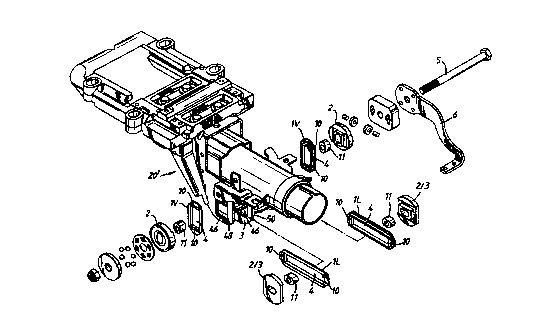Some of the information on this Web page has been provided by external sources. The Government of Canada is not responsible for the accuracy, reliability or currency of the information supplied by external sources. Users wishing to rely upon this information should consult directly with the source of the information. Content provided by external sources is not subject to official languages, privacy and accessibility requirements.
Any discrepancies in the text and image of the Claims and Abstract are due to differing posting times. Text of the Claims and Abstract are posted:
| (12) Patent Application: | (11) CA 2204156 |
|---|---|
| (54) English Title: | ADJUSTABLE STEERING COLUMN |
| (54) French Title: | COLONNE DE DIRECTION REGLABLE |
| Status: | Deemed Abandoned and Beyond the Period of Reinstatement - Pending Response to Notice of Disregarded Communication |
| (51) International Patent Classification (IPC): |
|
|---|---|
| (72) Inventors : |
|
| (73) Owners : |
|
| (71) Applicants : |
|
| (74) Agent: | NORTON ROSE FULBRIGHT CANADA LLP/S.E.N.C.R.L., S.R.L. |
| (74) Associate agent: | |
| (45) Issued: | |
| (86) PCT Filing Date: | 1995-11-13 |
| (87) Open to Public Inspection: | 1996-05-30 |
| Availability of licence: | N/A |
| Dedicated to the Public: | N/A |
| (25) Language of filing: | English |
| Patent Cooperation Treaty (PCT): | Yes |
|---|---|
| (86) PCT Filing Number: | PCT/GB1995/002658 |
| (87) International Publication Number: | WO 1996015931 |
| (85) National Entry: | 1997-04-30 |
| (30) Application Priority Data: | ||||||
|---|---|---|---|---|---|---|
|
A clamping mechanism for an adjustable steering column for a vehicle in which
antifriction elements (1) are provided which interpose between relatively
sliding components (2, 3) of an adjustable steering column construction (20)
each element allows sliding between limiting stops with resilient means (10)
between the stops to provide a soft stop. The resilient means may be a
separate member or resilient portions (10) at the ends of a slot (4) in the
element. Walls of the element may have longitudinal slits to take up
manufacturing tolerance.
Mécanisme de serrage pour la colonne de direction réglable d'un véhicule dans lequel des éléments antifrottement (1) sont prévus pour s'interposer entre des parties coulissantes (2, 3) relativement d'une construction (20) de colonne de direction réglable, chaque élément autorisant un coulissement entre des butées d'arrêt comprenant un moyen résilient (10) placé entre les butées pour assurer un arrêt en douceur. Le moyen résilient peut être un élément séparé ou des parties résilientes (10) prévues aux extrémités d'une fente (4) formée dans l'élément. Les parois de l'élément peuvent comporter des rainures longitudinales pour compenser la tolérance de fabrication.
Note: Claims are shown in the official language in which they were submitted.
Note: Descriptions are shown in the official language in which they were submitted.

2024-08-01:As part of the Next Generation Patents (NGP) transition, the Canadian Patents Database (CPD) now contains a more detailed Event History, which replicates the Event Log of our new back-office solution.
Please note that "Inactive:" events refers to events no longer in use in our new back-office solution.
For a clearer understanding of the status of the application/patent presented on this page, the site Disclaimer , as well as the definitions for Patent , Event History , Maintenance Fee and Payment History should be consulted.
| Description | Date |
|---|---|
| Inactive: IPC from MCD | 2006-03-12 |
| Application Not Reinstated by Deadline | 2003-11-13 |
| Time Limit for Reversal Expired | 2003-11-13 |
| Deemed Abandoned - Failure to Respond to Maintenance Fee Notice | 2002-11-13 |
| Inactive: Abandon-RFE+Late fee unpaid-Correspondence sent | 2002-11-13 |
| Letter Sent | 1997-09-22 |
| Inactive: First IPC assigned | 1997-08-11 |
| Inactive: IPC assigned | 1997-08-11 |
| Inactive: Notice - National entry - No RFE | 1997-07-29 |
| Inactive: Single transfer | 1997-06-30 |
| Inactive: Courtesy letter - Evidence | 1997-06-03 |
| Application Published (Open to Public Inspection) | 1996-05-30 |
| Abandonment Date | Reason | Reinstatement Date |
|---|---|---|
| 2002-11-13 |
The last payment was received on 2001-10-24
Note : If the full payment has not been received on or before the date indicated, a further fee may be required which may be one of the following
Please refer to the CIPO Patent Fees web page to see all current fee amounts.
| Fee Type | Anniversary Year | Due Date | Paid Date |
|---|---|---|---|
| Basic national fee - standard | 1997-04-30 | ||
| MF (application, 2nd anniv.) - standard | 02 | 1997-11-13 | 1997-04-30 |
| Registration of a document | 1997-06-30 | ||
| MF (application, 3rd anniv.) - standard | 03 | 1998-11-13 | 1998-10-21 |
| MF (application, 4th anniv.) - standard | 04 | 1999-11-15 | 1999-10-27 |
| MF (application, 5th anniv.) - standard | 05 | 2000-11-13 | 2000-10-24 |
| MF (application, 6th anniv.) - standard | 06 | 2001-11-13 | 2001-10-24 |
Note: Records showing the ownership history in alphabetical order.
| Current Owners on Record |
|---|
| THE TORRINGTON COMPANY LIMITED |
| Past Owners on Record |
|---|
| LAURENCE GEORGE HERBERT BARTON |